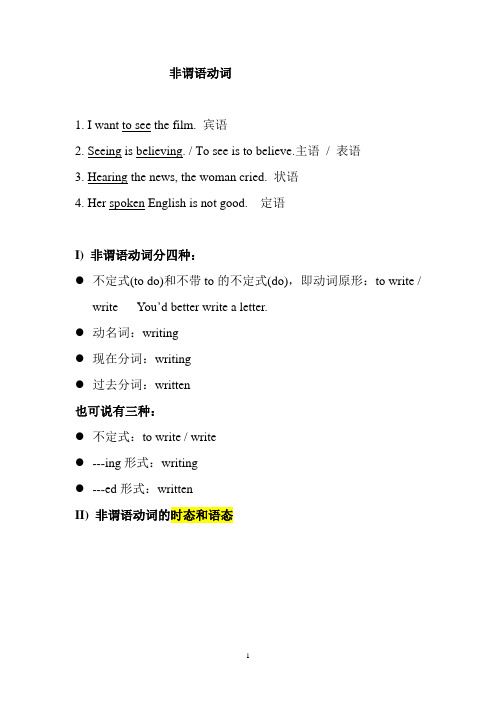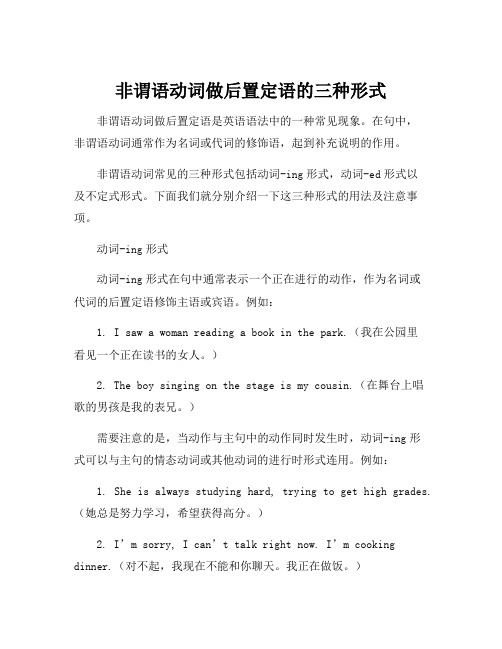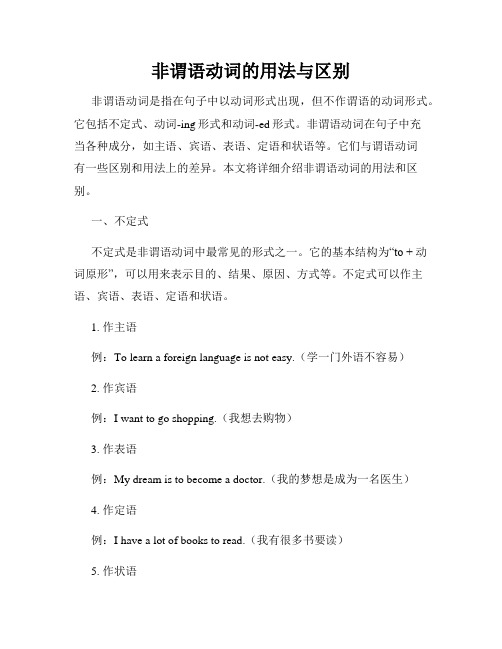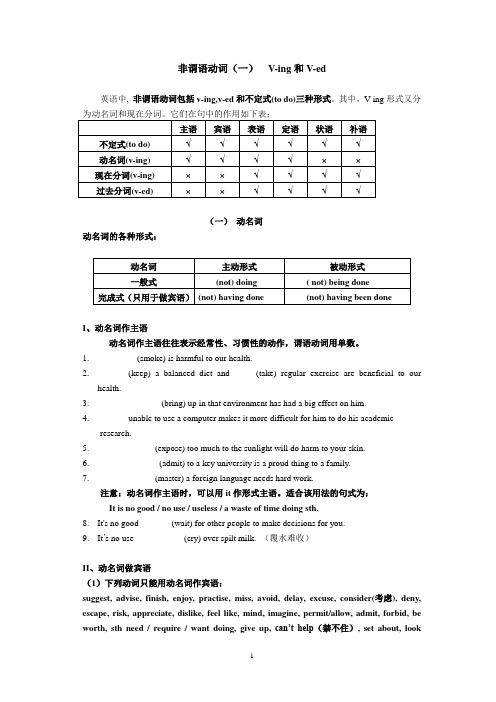非谓语动词(动词-ing形式和动词-ed 形式)
非谓语动词的三种形式及用法区别

非谓语动词的三种形式及用法区别一、非谓语动词的三种形式:1. 动词-ing形式:动词-ing形式具有动名词的功能,一般用来表示一个正在进行或发生的动作,以及被动含义,等。
比如:He was observed walking along the street. 他被观察到沿着街道走。
2. 动词不定式形式:动词不定式具有名词、形容词和动词的功能,常用来表示目的、动机、结果、条件、时间、让步等。
比如:To face the danger bravely is his duty. 勇敢的去面对危险是他的责任。
3. 动词的过去分词形式:动词的过去分词常用来表示完成或发生过的动作或状态,以及主句的谓语动词的被动的形式,常用结构有:Be + done/past participle (被动),Have/Get + done(完成).比如:The machine is now ready to be used. 这台机器现在准备好被使用了。
二、非谓语动词的用法区别:1. 动词-ing形式:(1) 用作定语:形容词性短语作定语修饰名词或代词,如:He was aman working hard. 他是个努力工作的人。
(2) 用作表语:Ing 形式的短语作表语,表示一个正在进行的动作或状态,如:His job is repairing the machine. 他的工作是修理机器。
2. 动词不定式形式:(1) 作宾补:动词不定式作宾补表示“目的”,“动机”,“结果”,“条件”,“时间”,“让步”等。
如:He came here to do something for us. 他来这里为我们做一些事情。
(2) 作状语:动词不定式作状语,表示“目的”,“动机”,“条件”,“时间”,“让步”等。
如:She always goes out for a walk to relax herself. 她总是出去散步来放松自己。
非谓语语法

I) 非谓语动词分四种:●不定式(to do)和不带to的不定式(do),即动词原形:to write /write Y ou’d better write a letter.●动名词:writing●现在分词:writing●过去分词:written也可说有三种:●不定式:to write / write●---ing形式:writing●---ed形式:writtenII) 非谓语动词的时态和语态III) 不定式在句中的功能:IV)---ing形式在句中的功能:V) 不定式to do和---ing形式的比较:●有些动词或词组后只能用---ing形式作宾语,而不能用不定式,如:◆admit,advise, avoid, appreciate, consider, enjoy, escape,finish, keep, mind, miss, postpone, practise, propose, resist,risk, suggest, give up, put off, can’t help, feel like等。
◆介词后用---ing形式,但be about to do sth例外◆It is no use / good doing sth, have difficulty / trouble doingsth, spend / waste time doing sth, there is no point (in) doingsth, it is waste of time / money doing sth●有些动词后只能用不定式作宾语,而不能用---ing形式,如:want, agree, choose, decide, hope, wish, plan, prepare, refuse, manage, promise, offer等●有些动词后面即可用不定式,也可用---ing形式,意思几乎无差别,如:like, start, begin, continue●有些动词后面即可用不定式,也可用---ing形式,但意思不同,如:remember, forget, regret, mean, try, stop, go on, prefere.g. He has forgotten to meet her. 他忘了要去见她。
非谓语动词-现在分词的讲解

非谓语动词非谓语动词包括不定式(to do)、动名词(-ing)、现在分词(-ing)与过去分词(-ed)。
它们不受主语人称和数的限制,在句子中不能充当谓语,但可以充当句子的其他成分,并且有时态和语态的变化。
动词-ing形式的要点1.-ing的形式2.-ing形式的基本用法(1)作主语:Seeing is believing. 眼见为实。
(2)作表语:Her job is washing and cooking.(3)作宾语:①作及物动词的宾语。
She likes drawing very much.②作某些短语动词的宾语。
Mary is thinking of going back to New York.③ do+限定词(my, some, any, the等)+v.-ing,表示“做…事”之如do some cleaning打扫卫生do some shopping购物④作介词的宾语:Her sister is good at learning physics.⑤作形容词worth, busy等的宾语:This book is well worth reading.只接动词-ing形式而不接不定式作宾语的动词有:admit 承认appreciate 感激avoid 避免put off推迟keep 保持consider 考虑delay/ postpone耽搁dislike 嫌恶resist 抵制mention 提及enjoy 喜欢escape 避免excuse 原谅practice 练习mind介意fancy想不到feel like 意欲finish 完成risk 冒险include 包括forgive 原谅give up 放弃suggest 建议miss 逃过imagine 想象can’t help 情不自禁involve 需要can’t stand无法忍受understand 理解常见的带介词to的短语:be used to 习惯be related to 与……有关get down to 着手做contribute to 贡献put one’s mind to全神贯注于give rise to 引起be equal to 胜任devote oneself to 献身于lead to 导致be opposed to 反对look forward to 盼望object to 反对stick to 坚持pay attention to 注意(4)作定语:The sleeping child is only five years old.(5)作宾语补足语:We can see steam rising from the wet clothes.可以带有这种复合宾语的动词有see, watch, hear, observe, feel, find, have, keep等。
非谓语动词做后置定语的三种形式

非谓语动词做后置定语的三种形式非谓语动词做后置定语是英语语法中的一种常见现象。
在句中,非谓语动词通常作为名词或代词的修饰语,起到补充说明的作用。
非谓语动词常见的三种形式包括动词-ing形式,动词-ed形式以及不定式形式。
下面我们就分别介绍一下这三种形式的用法及注意事项。
动词-ing形式动词-ing形式在句中通常表示一个正在进行的动作,作为名词或代词的后置定语修饰主语或宾语。
例如:1. I saw a woman reading a book in the park.(我在公园里看见一个正在读书的女人。
)2. The boy singing on the stage is my cousin.(在舞台上唱歌的男孩是我的表兄。
)需要注意的是,当动作与主句中的动作同时发生时,动词-ing形式可以与主句的情态动词或其他动词的进行时形式连用。
例如:1. She is always studying hard, trying to get high grades.(她总是努力学习,希望获得高分。
)2. I’m sorry, I can’t talk right now. I’m cooking dinner.(对不起,我现在不能和你聊天。
我正在做饭。
)动词-ed形式动词-ed形式通常表示完成的动作或对主语或宾语造成的影响或结果。
例如:1. The movie bored me. (这部电影让我感到无聊。
)2. The book written by the famous author was really good.(那个著名作家写的书非常好。
)需要注意的是,动词-ed形式还可以用来修饰某些情态动词或助动词,形成被动语态,例如:1. The letter has been written by my secretary.(这封信已经被我的秘书写好了。
)2. The house was built by my grandfather many years ago.(这个房子是我祖父很多年前建造的。
非谓语动词(动词ing形式和动词ed形式)课件

03
Hale Waihona Puke 动词ed形式可以作为状 语,表示动作发生的时 间、原因、条件等。
04
例如:He was born in 1990.(他出生于1990 年。)
动词ed形式与分词的区别
动词ed形式与分词在语法功能和用法 上存在显著差异。
例如:I have seen the movie.(我 已经看过这部电影了。)(动词ed形 式)
动词ing形式表示正在进行的动作或行为,而动名词表示已经完成或结果的状态。
动词ing形式在句子中做主语或表语时,表示一个动作或行为,而动名词则表示一个 名词概念。
03 动词ed形式
动词ed形式的构成
动词ed形式由动词原形加-ed构成,规则动词的-ed形式一般直接在词尾加-ed。 例如:work -> worked,play -> played。
表示被动关系
如"The book was written by him."。
表示习惯或经常性的行为
如"He likes reading books."。
表示时间或条件状语
如"If you study hard, you will succeed."。
动词ing形式与动名词的区别
动词ing形式既可以作为谓语的一部分,也可以作为独立成分,而动名词只能作为谓 语的宾语或表语。
非谓语动词的语态
主动语态
表示非谓语动词所表示的动作是 由句子主语发出来的。
被动语态
表示非谓语动词所表示的动作不 是由句子主语发出来的,而是被 其他人或物完成的。
非谓语动词时态和语态的用法
过去分词可以用于描述已经完成 的动作或存在的状态,常与时间 状语连用,如“已经”、“已经 完成”、“已经达到”等。
非谓语ing和ed做形容词

非谓语ing和ed做形容词
非谓语动词是指动词的非谓语形式,包括动词的现在分词(-ing形式)和过去分词(-ed 形式)。
这两种形式常常用来表示某一行为的状态或性质。
在英语中,非谓语-ing和-ed 可以用来做形容词,用于表达一个名词的性质或特征。
这种用法非常常见,我们可以在日常生活中的各种场合中见到。
-ing形式作为形容词,通常用来表示某个名词所处的状态或行为。
比如:
1. She had a boring day at work.(她上班那天很无聊。
)
2. The running water is so cold.(这流水太冷了。
)
3. I'm smelling something delicious.(我闻到了一些美味的味道。
)
在这些例句中,-ing形式修饰的名词分别是day(日子)、water(水)和something (某物),表示它们所处的状态或行为。
-ed形式做形容词
因为这两种形式都可以用来表达某个名词的性质或特征,所以他们也常常作为动词的补语或是形容词短语,例如:
3. She was fascinated by the scenery.(她被景色所吸引。
)
在这些例子中,-ed和-ing形式都充当了动词的补语,用来描述主语的感受或感受的对象。
这种用法可以使句子更加生动有趣。
总之,非谓语动词-ing和-ed做形容词的用法非常灵活,可以用来表示名词的状态、特征或经历,同时也可以作为动词的补语,使句子更加丰富、生动。
只需要不断地练习,就可以掌握它们的使用方法并增强自己的表达能力。
英语语法解析 动词-ing形式与动词-ed形式的区别

英语语法解析动词-ing形式与动词-ed形式的区别动词-ing形式与动词-ed形式都属于非谓语动词,在语法功能上非常相似,但意义相差较大。
-ing形式一般表示主动含义,表示正在进行的或一般性的动作;而-ed形式一般表示被动含义,表示已经完成或被动的动作。
1.动词-ing形式具有名词的性质,所以它在句中可以作主语和宾语,而动词-ed形式不具有名词的性质,所以在句中不能作主语和宾语。
Taking exercise is beneficial to our health. 锻炼对我们的健康有益。
(主语)She suggested going shopping this Sunday. 她建议这个星期天去购物。
(宾语)2.动词-ing形式和动词-ed形式作定语的区别动词-ing形式作定语一般表示主动含义,而动词-ed形式作定语一般表示被动含义(不及物动词的过去分词一般表完成,不表被动);动词-ing 形式作定语一般表示动作正在进行,而动词-ed形式作定语一般表示动作已经完成。
I’m glad to hear the exciting news. 我很高兴听到这个令人兴奋的消息。
(表主动)The cat drawn by the boy was very lovely. 男孩画的猫非常可爱。
(表被动)The ground was covered fallen leaves. 地上覆盖着落叶。
(不及物动词表完成)The rising sun is a symbol of hope. 冉冉升起的太阳象征着希望。
(表动作正在进行)They looked up at the risen sun. 他们仰望着已升起的太阳。
(表动作完成)3.动词-ing形式和动词-ed形式作表语的区别动词-ing形式作表语一般表示主语的性质和特征,含义为“令人……”;动词-ed形式作表语一般表示人的感受,含义为“(某人)感觉……”。
非谓语动词(动词不定式、ing分词、ed分词)

动词不定式的逻辑主语:
B: 下列形容词作表语时,不定式前常加一个 of 引起 的短语来说明逻辑主语,这些形容词(表评价性的, 来说明逻辑主语的性质,特征,属性)是: kind, good, nice, wise, unwise, clever, silly, stupid, foolish, wrong, right, careless, rude, polite等. It’s kind of you to think so much of us. It’s unwise of him to leave home at once. It ‘s wrong of him to speak bad behind others. It’s wrong of the south to break away f谓语、宾语、定语、状语、补语
4
The famous doctor helped
the pregnant woman to give birth to a baby last Friday.
主 谓 宾 定 状 补
5
定 The pregnant woman was helped 状 主补 to give birth to a baby last Friday.
2)进行式:不定式的进行式所表示的动作与谓 语动词动作同时发生,例如:
The boy pretended to be working hard. He seems to be reading in his room. 3)完成式:不定式的完成式表示的动作发生在 谓语动词动作之前,例如: I regretted to have told a lie. I happened to have seen the film. He is pleased to have met his friend.
非谓语的十种形式

以下是非谓语的十种形式:
不定式:to + 动词原形。
例如:to see,to go,to eat等。
动名词:动词-ing形式。
例如:seeing,going,eating等。
分词:动词-ed或-ing形式。
例如:seen,going,eating等。
带to的动词不定式:介词后面接to+动词原形。
例如:to look forward to,to be used to等。
带-ing的动词不定式:介词后面接动词-ing形式。
例如:after finishing,before leaving等。
现在分词:动词-ing形式作状语或者形容词。
例如:a boring movie,a singing bird等。
过去分词:动词-ed形式作定语或者表语。
例如:a broken window,a disappointed look等。
独立主格:动词-ing形式或过去分词形式作状语。
例如:The weather being fine, we went for a picnic.,The homework done,
he went out to play.
不定式短语:不定式作主语、宾语、表语、定语等。
例如:To learn English well is important.,I want to eat some fruit.
分词短语:分词作定语、状语、表语等。
例如:A sleeping baby,The story told by him.。
新教材2025版高中英语语法精讲4非谓语动词综述学案牛津译林版选择性必修第一册

语法精讲④非谓语动词综述非谓语动词通常指动词不定式、动词-ing形式和动词-ed形式。
它们的基本形式的改变1.非谓语动词作主语:动词不定式与动词-ing形式(1)动词不定式作主语动词不定式作主语相当于名词,单个动词不定式(短语)作主语时,谓语动词常用单数。
❶To climb the mountain road is easy while to go down the hills is hard.上山简单下山难。
[特殊留意] 在当代英语中,常用it作形式主语,将真正的主语(不定式)放在后面。
It is not easy to find your way around the town.在这个小镇要找到路很不简单。
(2)动名词(短语)作主语动名词具出名词的基本性质,因此动名词可以在句子中充当主语。
单个动名词(短语)作主语时,句子的谓语动词通常用单数。
①动名词(短语)在句首干脆作主语。
❷Reading aloud is very important for us to learn a foreign language.大声朗读对我们学外语来说很重要。
②it在句首作形式主语,而动名词(短语)作句子真正的主语,常用表达有:It's a waste of time doing sth.做某事奢侈时间It's useless/worthwhile doing sth.做某事是没用的/值得的It's no use doing sth.做某事是没用的It was a waste of time reading that book.读那本书就是在奢侈时间。
(此句中It为形式主语,真正的主语为reading that book) 2.非谓语动词作宾语:动词不定式与动词-ing形式(1)接动词不定式作宾语的动词(短语)英语中有些动词或动词短语应接不定式作宾语,常用的有:afford(负担得起),agree(同意),arrange(支配),ask(恳求),attempt(尝试),choose(选择),desire(渴望),decide/determine (确定),expect(预料),fail(失败;未做到),help(帮助),hope(希望),intend(准备),learn(学习),manage(设法做成),offer(情愿),plan(支配),prepare(准备),pretend(假装),promise(许诺;答应),refuse(拒绝),wish(希望),would like/want(想要)等。
非谓语做状语的句子特征

非谓语做状语的句子特征非谓语动词包括不定式(to do)、动名词(-ing)、现在分词(-ing)与过去分词(-ed)。
它们不受主语人称和数的限制,动词不定式定义:动词不定式是非谓语动词的一种,它没有人称和数的变化,在句子中不能独立作谓语,但它仍保持动词的特点,可以有自己的宾语和状语。
1. 不定式的一般式:一般式表示的动作或状态发生在谓语动词表示的动作或状态的同时或之后。
当不定式的逻辑主语是这个不定式所表示的动作的承受者时,不定式一般要用被动式(to be done).eg: He seemed to be tired.The building to be finished next month is for our teachers.2. 不定式的进行式:进行式表示动作正在进行,与谓语的动作同时发生。
e.g. When I went to his home, he happened to be traveling around the world.3. 不定式的完成式:如果不定式所表示的动作或状态发生在谓语动词所表示动作或状态之前,就用完成式;若是在此基础上的被动含义,就用完成被动式( to have been done).e.g. He is said to have written a novel about the Long March.He is said to have been taught French when he was a child.4. 不定式的完成进行式:如果不定式的动作是在谓语所表示的时间之前一直在进行或有可能继续进行的动作,就要用完成进行式.eg: We’re happy to have been working with the experts all the month.二、不定式的用法:1. 不定式做主语:不定式做主语一般表示具体的某次动作。
而动名词doing 表示习惯的,经常的动作。
英语语法 非谓语动词

第 14 章非谓语动词【基础知识·归纳】非谓语动词指的是不能单独作谓语, 但 同时仍保留动词某些特征的动词形式。
非谓 语动词主要有动词不定式、动词-ing 形式和 动词-ed 形式三类。
它们没有人称和数的变 化,但可以有自己的宾语、状语等。
定式的进行式有时也可表示将来 The old man seems to be dying. 这老人似乎要死了。
He was happy to be coming home. 就要回家了他感到高兴。
(3) 不定式完成式 ① 表示发生在谓语动作之前的动作 I hate to have quarreled with her. 我后悔和她吵架了。
I’m sorry to have given you so much trouble. 对不起给了你这么多麻烦。
② 表示在某个给定的时间之前已完成的动 作 I hope to have finished the work by now. 我希望现在以前已完成这项工作。
③ 表示过去未实实现的想法和愿望 I should like to have come earlier. 我本想早点来的。
We were to have been married last year. 我们本来打算去年结婚的。
(4) 不定式完成进行式 表示在谓语动作之前一直在进行的动 作。
You seem to have been writing very long. 你好像已经写了很久了。
The battle was said to have been going on for two days. 据说战斗已经进行两天了。
(5) 不定式被动语态 不定式到底用主动形式还是被动形式, 往往取决于句子的意思, 即意思上为主动就 用主动形式,意思上为被动就用被动形式。
Did it need to be done so soon? 这事需要这么快就做吗? I’m pleased to have been given this opportunity. 给了我这次机会我很高兴。
非谓语动词笔记

非谓语动词非谓语动词指不能单独作谓语,但同时仍保留动词某些特征的动词形式。
非谓语动词主要有不定式、V-ing形式、V-ed形式三类。
它们没有人称和数的变化,但是有的有时态和语态形式变化,还可以有自己的宾语、状语、逻辑主语等。
1、定义:在句中不充当谓语的动词称作非谓语动词。
2、形式:doing---动名词to do---不定式分词---现在分词doing 过去分词---done3、后跟doing型(偏执型)a) 动词+doing:例:enjoy, keep, be busy, finish, mind, can`t help, spend+时间+doing。
b) 介词+doing:例:after, before, feel like注意:“to”作为介词时后跟doing。
例:I go to school.“to”作为不定式时后跟do.例:I want to read the English books.常考短语:look forward to doing----期盼。
例:I look forward to receiving your letter.Be used to doing----习惯于。
例:I am used to walking my bear at 24.Prefer doing A to doing B----宁愿做…也不愿做...例:I prefer reading English books to watching TV.c) 后跟doing表被动在need, want, require, be worth后加doing表示被动例:My bag needs mending.4、后跟to do 型(偏执型)a) 动词+to do 例:I ask you to go swimming with a shark.记忆口诀:要想拒绝命令,决定告诉教警。
Ask, want, refuse, order, decide, tell, teach, warn注意:否定形式在to do 前加notb) 特殊疑问词+to do=从句注意why后加裸不定式,省略to例:I don`t know whether to buy it.c) 后跟裸不定式省略to记忆口诀:一感,二听,三使,四看(snow),半帮助Feel, listen to/hear, make/let/have, see/notice/observe/watch, help使用规则:1) 这些动词后跟to do时,省略to.例:No one can make my cry.2) 其中一感,二听,四看,半帮助动词,后也可加do/doing.例:I see him steal / stealing.3) 当这些词用于被动时,后跟to do(被动语态恢复to) 例:He was made to cry.语法重点:无头鬼句型一北京的一个年轻人厌倦了睡在地板上。
2020年中考英语语法非谓语动词

A. visit B. visiting C. visited D. to visit 8. — Jack, why have you decided __D_ Chinese
folk music as a courses. — To learn more about Chinese culture.
形式主语代替动词不定式的常用句型为: It’s + adj. + (of / for sb.) to do sth.或 It’s +n. + (for sb.) to do sth. It takes sb. some time to do sth. 。 e.g. It’s very nice of you to offer me a seat.
2. 使役动词(如make, let等)及感官动词(如 see, feel, hear, watch, notice等)后跟动词 不定式作宾语补足语时需省略to。 注意在变为被动语态时要加上to。 e.g. I saw a young man enter the room. She was often heard to sing this song.
2. It often takes me two hours __C____ my homework in the evening. (2018 广西桂林) A. do B. doing C. to do
3. —Could I go swimming with my friend, dad?
— No, it’s very dangerous for you kids __C____ swimming without adults. (2018 广西河池)
非谓语动词(动词ing形式和动词ed形式)课件

用法
示例
独立主格结构是一种特殊的句式,其中非 谓语动词(动词ing形式或动词ed形式) 与主句主语保持独立关系,有自己的主语 ,表达完整的意义。
在句子中,独立主格结构通常放在句子的 末尾,表示一种伴随、条件、时间等关系 ,使句子更加丰富和灵活。
The meeting over, the group of people started to leave.(会议结束, 那群人开始离开。)
04
填空题解析
句子的主语是the book,而谓语 是is,因此需要用非谓语动词来 描述book的状态或动作。由last year可知,此处需要用过去分词 形式published。因此,答案为 published。
动词ing形式的用法
01
作为主语补足语
表示主语正在进行的动作或状 态,例如:The man running
in the park is my friend.
02
作为宾语补足语
补充说明宾语的性质、状态或 正在进行的动作,例如:I saw
him playing basketball on the court.
改错题
Having a rest, he continued his work.
填空题
The book ___(publish) last year is very popular.
解析与答案
01 完成句子解析
enjoy后面接动词时,一般用动 名词形式,即reading。因此, 答案为reading。
02
选择题解析
句子的主语是the book,而谓 语是is,因此需要用非谓语动词 来描述book的状态或动作。由 by可知,此处需要用过去分词 形式written。因此,答案为 written。
非谓语动词的用法与区别

非谓语动词的用法与区别非谓语动词是指在句子中以动词形式出现,但不作谓语的动词形式。
它包括不定式、动词-ing形式和动词-ed形式。
非谓语动词在句子中充当各种成分,如主语、宾语、表语、定语和状语等。
它们与谓语动词有一些区别和用法上的差异。
本文将详细介绍非谓语动词的用法和区别。
一、不定式不定式是非谓语动词中最常见的形式之一。
它的基本结构为“to + 动词原形”,可以用来表示目的、结果、原因、方式等。
不定式可以作主语、宾语、表语、定语和状语。
1. 作主语例:To learn a foreign language is not easy.(学一门外语不容易)2. 作宾语例:I want to go shopping.(我想去购物)3. 作表语例:My dream is to become a doctor.(我的梦想是成为一名医生)4. 作定语例:I have a lot of books to read.(我有很多书要读)5. 作状语例:He comes to help us.(他过来帮助我们)二、动词-ing形式动词-ing形式是非谓语动词的另一种形式。
它的基本结构为动词原形+ing,可以作主语、宾语、表语、定语和状语。
1. 作主语例:Swimming is good for health.(游泳对健康有益)2. 作宾语例:I enjoy reading books.(我喜欢读书)3. 作表语例:His favorite activity is playing basketball.(他最喜欢的活动是打篮球)4. 作定语例:The running water sounds like music.(流动的水听起来像音乐)5. 作状语(表示时间、原因、方式等)例:She fell asleep while watching TV.(她看电视的时候睡着了)三、动词-ed形式动词-ed形式是非谓语动词中的一种形式,通常表示被动、完成等含义。
非谓语动词V-ing和v-ed

非谓语动词(一)V-ing和V-ed英语中, 非谓语动词包括v-ing,v-ed和不定式(to do)三种形式。
其中,V-ing形式又分为动名词和现在分词。
它们在句中的作用如下表:主语宾语表语定语状语补语不定式(to do) √√√√√√动名词(v-ing) √√√√××现在分词(v-ing) ××√√√√过去分词(v-ed) ××√√√√(一)动名词动名词的各种形式:动名词主动形式被动形式一般式(not) doing ( not) being done 完成式(只用于做宾语)(not) having done (not) having been doneI、动名词作主语动名词作主语往往表示经常性、习惯性的动作,谓语动词用单数。
1._________(smoke) is harmful to our health.2._______(keep) a balanced diet and______(take) regular exercise are beneficial to ourhealth.3. ______________ (bring) up in that environment has had a big effect on him.4. _______unable to use a computer makes it more difficult for him to do his academicresearch.5. _____________(expose) too much to the sunlight will do harm to your skin.6. ______________(admit) to a key university is a proud thing to a family.7. _____________(master) a foreign language needs hard work.注意:动名词作主语时,可以用it作形式主语。
非谓语动词语法讲解

非谓语动词分类 不定式(to do) 动词ing -ed 形式
非谓语动词可以担当的成分
1.To see you is glad. (作主语) 作主语) =It’s glad to see you. 2.I want to see you. (作宾语) 作宾语) 作宾语 3.My hope is to see you. (作表语) 作表语) 作表语 4.I want him to see you. 作宾补) (作宾补) 5.He is the man to see you.(作定语) 作定语) 6.I’m glad to see you.(作原因状语) 作原因状语) (作目的状语) 7.I went to see you. 作目的状语) 8.He went so early as to see you
(5)注意有些动词如:advise,permit ,allow,admit, 注意有些动词如: 注意有些动词如 , , , forbid,imagine,consider接不定式与接 接不定式与接~ing形式的不同 , , 接不定式与接 形式的不同 结构。 结构。 ①这些动词后面跟复合宾语时,用不定式作宾补。 这些动词后面跟复合宾语时,用不定式作宾补。 advise/permit/allow/admit/forbid/imagine / / / / / /consider…sb.to do sth. . . 这些动词后面直接跟非谓语动词时, ②这些动词后面直接跟非谓语动词时,用动名词 ~doing. advise/permit/allow/admit/forbid/imagine / / / / / /consider…doing sth.
如果这个作定语的不定式是一个不及物动词, 如果这个作定语的不定式是一个不及物动词, 注意不可忽略不定式短语中的副词或介词。 注意不可忽略不定式短语中的副词或介词。 如:I need a pen to write with.(可看成:to write with the pen) She now has nothing to worry about.(可看 成:to worry about nothing)
- 1、下载文档前请自行甄别文档内容的完整性,平台不提供额外的编辑、内容补充、找答案等附加服务。
- 2、"仅部分预览"的文档,不可在线预览部分如存在完整性等问题,可反馈申请退款(可完整预览的文档不适用该条件!)。
- 3、如文档侵犯您的权益,请联系客服反馈,我们会尽快为您处理(人工客服工作时间:9:00-18:30)。
great victories.
3. 作方式或伴随状语,不用v.-ing被动式,而用过去分词。 例如:The soldiers lay on the ground, covered with nothing.
4. 作时间状语,若动作先于句子的谓语动作发生,且有具 体的过去时间,不可用 v.-ing一般被动式或完成被动式。例 如:Built in 1192 , the bridge was very useful.
He got his watch repaired. (repaired不能改为being repaired
或to be repaired) 6. 在make, order, want, like, wish等动词后,多用过去分词作 宾语补足语,少用v.-ing被动式作宾语补足语。例如: The speaker couldn’t make himself heard.( 一般不说 being heard)
如果没有具体的过去时间状语,可用过去分词或v.-ing完
成 被 动 式 。 例 如 : Discussed( = Having been discussed) many times, the problem was settled at last. 如果要强调分词状语的动作发生的时间在谓语动作之前, 则 宜 用 v.-ing 完 成 被 动 式 , 而不 用 过 去分 词 。 例如 : Not
making
being made
going
having made (不作定语)
having been made (不作定语)
having gone (不作定语)
-ed
只有一般式:不强调时间先后, 只说明原因、条件等
×
made(表被动)
gone(表完成)
v.-ing
1.作主语 Seeing is believing. 注意: it 作形式主语时,可用动词不定式,但下列句型常用动
8. get, become, look, seem, appear, remain等系动词后都可跟
done, 表示被动或主语的状态,如remain seated/hidden, get
paid/dressed/changed/stuck/hurt/injured/ burnt等。 注:常用be done+介词短语表示所处的状态,如下: be addicted to… be absorbed in… 沉迷于„„ 全神贯注于„„
【解析】选C。suggest后面要接动名词作宾语,A项是动名词 的完成式表示发生在谓语动词suggested之前的 一个动作,由 句意可知不合题意。
5. 作状语: ①时间状语:Reading the letter, I couldn’t help thinking of my school life. ②原因状语:Being ill, I didn’t go to school yesterday. ③方式或伴随状语:Mary stood at the school gate waiting for Betty.
7.v.-ing 的语态 doing being done
having done having been done
being left at home. (1) He was afraid of __________ having been damaged (2) The house showed no sign of _____________________. 注意: 有些v.-ing在句中虽是主动形式,却有被动含义。
delay, imagine, include, keep, quit, resist, pay attention to等
动词以及介词后接动名词作宾语。
跟踪演练
Bill suggested _____ C a meeting on what to do for the Shanghai
Expo during the vacation. A. having held C. holding B. to hold D. hold
having been invited, she had to stay at home.
5. 在have, get之后宜用过去分词作宾语补足语,不用v.-ing被 动式或不定式被动式作宾语补足语。例如: I’ll have my hair cut. (cut不能改为being cut或be cut)
7.心理状态动词的-ing形式与-ed形式
所谓心理状态动词是指含有使动意义,使人产生某种情
感、心理变化的动词。例如:surprise使惊讶;interest使感
兴趣。它们的 -ing 形式含主动意义, -ed 形式含被动意义。
皆可视为形容词。例如:surprising令人惊讶的;interesting 令 人 感 兴 趣 的 ; surprised ( 因 „„ ) 感 到 惊 讶 的 ; interested (因„„)感兴趣的。下面的句子可显示两者的 区别: The film is so interesting that they are all interested in it. She was much surprised at the surprising news.
6.v.-ing的时态:一般式和完成式 ( 1 )如果动作没明确表示出时间是与谓语同时发生或在谓 语之前发生,用一般式。 playing chess. We are interested in _______ ( 2 )如果动作发生在谓语动词所表示的动作之前,通常用 完成式。 having kept my promise. I’m sorry for not ___________ ( 3 )在某些词后,常用一般式,尽管其动作是在谓语所表 示的动作之前发生的。 On hearing the bad news, she cried. I’ll never forget seeing that film for the first time.
【解析】选C。encourage与主句主语many farmers之间为逻
辑上的动宾关系,因此应用被动形式,故排除B、D两项;A
项表示该动作正在进行,不符合题意;Encouraged by the
advances in technology为过去分词短语作原因状语。
v.-ing被动式与过去分词用法的区别 1. 作宾语时, v.-ing的一般被动式表示一个正在发生的被动
(2)短暂动词(即瞬间动词)的现在分词被动式不可作宾语
补足语或定语。例如:
He saw the old man knocked down by the car. (knocked
down不可改为being knocked down或having been knocked
down)
v.-ed 形式 1. 作定语:The stolen car was found by the police last week. 2. 作表语:The glass is broken. /When I got to the classroom, the door was locked. 3. 作宾语补足语:You must get/have your hair cut. 4. 作状语:Given more time, we can do the work much
better.
跟踪演练
1. Now that we’ve discussed our problem, are people happy with the decisions _____? C A. taking B. take C. taken D. to take
【解析 】选C。句意:既然我们已经讨论了我们的问题,
The house requires / needs / wants repairing.
The book is worth reading.
8. 固定句型 (1)There is no use/good/sense/harm+doing sth. 做某事没用
(不好/没意义/没有害处)
(2)have difficulty/trouble/problems/a hard time/a good time/ fun + (in)+doing (3)spend/waste/lose time (in) doing sth. (4)There is no... + doing sth. (there is no 表“不可能”)
be aimed at…
be armed with… be buried in…
旨在/意图„„
有„„装备 埋葬在„„
be based on/upon…
9 .使用v.-ing的几个注意点
(1)作状语用的现在分词,其逻辑主语必须同句中主语为同
一人或同一事。例如:
Standing on top of the tall building, we could see the whole
city.(正) (Standing=When we stood) Standing on top of the tall building, the whole city could be seen.(误)
非谓语动词(动词-ing形式和动词-ed 形式)
性质
非谓语动词具有动词的特点,但在句子中起着名词、
形容词、副词的作用,充当主语、表语、定语、宾语、
宾语补足语、状语,即:除谓语以外的一切成分。
非谓语动词时态&语态对照表
及物与不及物 语态 类别 时态 vt. vi.
主动语态
被动语态
主动语态
一般式: (与谓语动词同时发生) -ing #43; no good (no use, fun, a waste of time) +doing…
